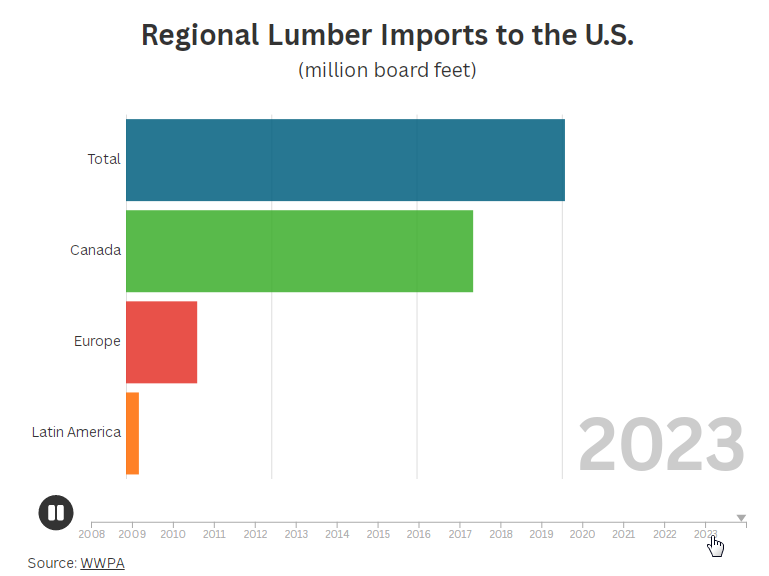The US-Canada lumber trade is a cornerstone of the North
American forest products industry, frequently spotlighted for
its tariff disputes and economic stakes. Recent policy shifts
have reignited discussions about supply chains, costs, and
market resilience, often casting the relationship as a
battleground of competing interests. Yet, beneath the headlines
lies a more intricate story—one of interdependence, mutual
benefit, and evolving global dynamics that shape the forest
value chain.
Summary: US Tariffs on Canadian Lumber – April 2025 Update
As of April 7, 2025, Canadian softwood lumber faces a 14.54% US
tariff rate, set by the Department of Commerce in August 2024,
supplying about 30% of US demand. A proposed 25% tariff on
Canadian goods, announced in March 2025, was delayed and
ultimately exempted for lumber on April 2, averting a jump to
39.5%.
However, the Commerce Department’s sixth review, due in late
2025, may raise duties to 27% or more, while a Section 232
national security probe could add further pressure. For the
forest value chain, this signals ongoing volatility—Canadian
producers face margin squeezes, US buyers brace for cost hikes,
and global suppliers may gain ground—underscoring the need for
strategic adaptability in this critical trade corridor.

A Closer Look at Trade Flows
Canada remains the largest supplier of softwood lumber to the US
This volume, valued at $8-10 billion, accounts for 25-30% of US
consumption, driven primarily by residential construction
demand. In 2022, US housing starts, ranging from 1.4-1.6 million
units, underscored this need, supplementing domestic production
of 35-40 billion board feet. However, the US is not solely
reliant on Canadian imports; it also exports softwood lumber
back to Canada— often in species like Southern Yellow Pine,
which is not widely produced north of the border.
Yet, as Canada's ability to meet US demand faces challenges—such
as mill closures and tariff implications —Europe has
historically played a critical offsetting role. Since 2020,
European suppliers have increasingly stepped in during Canadian
supply disruptions, a trend that shows signs of accelerating.
This evolving dynamic introduces new competition into the North
American market and may increasingly influence pricing and
supply chain strategies.
Beyond raw lumber, finished forest products add another layer of
complexity to the trade relationship. In 2021, US exports of
paper, paperboard, and packaging to Canada totaled $10.3
billion, reflecting a 14.5% increase from the previous year amid
rising e-commerce demand. These goods—ranging from corrugated
boxes to industrial papers—illustrate the two-way nature of the
trade, where Canadian lumber is processed in the U.S. and
returned as higher-value products. If tariffs escalate, as seen
in previous tariff disputes, such dynamics could face
disruption, increasing costs across the supply chain.
The Utilization and Economic Impact of Trade
Most of the Canadian lumber entering the US supports domestic
construction, with an estimated 70-80% used in housing and
related projects. The remainder supports manufacturing,
including furniture, engineered wood products like plywood, and
residuals repurposed for pulp and paper. A portion—likely
10-15%—is transformed into goods for export, generating added
value. For example, US furniture exports to Canada totaled
$500-600 million in 2021, while global plywood exports reached
$1.2 billion, with Canada as a key market.
While tariffs can compress margins, it doesn’t fully halt trade.
The integrated North American supply chain—Canada providing raw
materials and the US leveraging manufacturing capacity—remains a
cornerstone of the industry, despite ongoing duties and proposed
increases in 2025.
Unpacking the "Trade War" Narrative
The US-Canada lumber relationship is often distilled into a
narrative of conflict, with historical disputes like the
Softwood Lumber Agreements and recent tariff announcements
fueling the perception of a "trade war." US producers point to
Canadian stumpage fee structures as a subsidy, while Canada
emphasizes its role in meeting US demand. But the data reveals a
more balanced exchange: Canada relies on the US for over 70% of
its lumber export market, while the US benefits from both
Canadian supply and export opportunities for finished goods.
This interdependence contrasts with calls for rapid US
production increases. While expanding domestic capacity could
offset imports, the scale and timeline of such efforts face
practical limits, leaving cross-border trade a critical factor
in meeting US demand.
Beyond the Headlines: A Nuanced Exchange
The US-Canada lumber trade is not a simple story of dependency
or rivalry but rather a multifaceted partnership shaped by
geography, economics, and market needs. While tariffs and policy
shifts continue to evolve, their impact will ripple through
construction costs, manufacturing profitability, and bilateral
flows. A closer look at the data offers a clearer understanding
of the industry at a pivotal moment.
The trade flows between the US and Canada are not purely
one-sided but reflect a long-standing and mutually beneficial
relationship. The US imports raw lumber from Canada but also
contributes significant exports of finished products back to
Canada. This ongoing exchange serves both countries' needs,
creating a balanced ecosystem in the North American forest
products industry.
While it is easy to oversimplify this relationship into a
narrative of conflict, the reality is much more nuanced. The two
nations depend on one another in ways that extend beyond just
raw lumber and include valuable finished goods that flow both
ways. Understanding the complexities of this trade allows for a
deeper appreciation of how vital US-Canada cooperation is in
sustaining the forest products industry.
Looking Ahead
As tariffs, regulations, and policy shifts continue to unfold,
they will undoubtedly have an impact on construction costs,
manufacturing profitability, and bilateral trade flows. However,
these shifts should not overshadow the deeper interdependencies
at play. The US and Canada are not engaged in a trade war, but
rather, a partnership marked by mutual benefit and economic
integration.
By moving beyond the simplified headlines, we gain a clearer
view of an industry that thrives on collaboration, not conflict.
Understanding these dynamics helps businesses in the forest
products sector navigate potential disruptions and make informed
decisions about their future strategies.
Source:
resourcewise.com